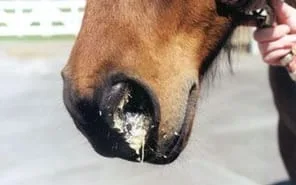STRANGLES
FREQUENTLY ASKED QUESTIONS


1. What causes Strangles?
Strangles is a highly contagious disease caused by the bacterium Streptococcus equi subspecies equi (S. equi var. equi). Strangles commonly affects young horses (weanlings and yearlings), but horses of any age can be infected. Strangles is shed in nasal secretions, including through direct nose-to-nose contact between horses, or through the contamination of a shared environment (water troughs, hoses, feed bunks, pastures, stalls, trailers, tack, grooming equipment, nose wipe cloths or sponges, attendants’ hands and clothing, or insects contaminated with nasal discharge or pus draining from lymph nodes of infected horses).
2. What are the clinical signs of Strangles?
Clinical signs may include fever (102-106o F); decreased appetite or complete loss of appetite, large amounts of thick yellow nasal discharge, difficulty swallowing, respiratory noise (stridor) or difficulty breathing, enlarged or abscessed/draining lymph nodes (particularly those lymph nodes under the jaw and within the throat latch region). Some horses become profoundly sick and require hospitalization, while others appear to only have a small cold and are overlooked. After clinical signs resolve, some horses will remain asymptomatic shedders of the bacteria, and can go on to infect other horses.
3. What is an asymptomatic shedder?
After a horse recovers from Strangles the bacteria can continue to reside in the guttural pouch and be intermittently shed. These horses have no clinical signs, but continue to be a source of infection. These horses are often the cause of Strangles outbreaks. In order to diagnose an asymptomatic shedder, the guttural pouch must be evaluated using an endoscope and guttural pouch lavage sample submitted for culture/PCR testing. Asymptomatic shedders can be eliminated by flushing and treating the guttural pouch with penicillin gel to sterilize the area.
4. How is Strangles definitively diagnosed?
Strangles can be diagnosed by culturing the bacteria or by performing a highly sensitive PCR test on nasal or guttural pouch discharge samples. These samples can be taken using a nasal swab, a nasopharyngeal wash (saline rinse of the back of the throat) or through endoscopic guttural pouch lavage.
5. How is Strangles treated?
Once a horse has enlarged or draining lymph nodes, the disease is best allowed to run its course and the horse is often managed using only anti-inflammatories and supportive care. Horses that are are not eating/drinking, or those that have respiratory distress will be treated with antibiotics. Antibiotics can prolong the course of disease and are not recommended unless absolutely necessary. During an outbreak, all horses on the premises will have their temperatures taken at least twice daily. Horses with new fever caught prior to the development of lymph node enlargement can be treated with antibiotics to halt the progression of disease. The pus that collects within the guttural pouch can be flushed out to promote drainage and in an attempt to prevent the development of asymptomatic shedders. It is recommended that horses have a guttural pouch endoscopy 6 weeks beyond the resolution of clinical signs in order to make sure asymptomatic shedder status doesn’t develop, which could reignite an outbreak.
6. How are Strangles outbreaks controlled?
During a strangles outbreak all horse movement on and off the farm must stop. No new horses should come onto the premises and no horses currently residing at the farm may leave. Horses diagnosed with strangles are isolated away from the healthy herd. Temperatures in the healthy horse group are taken at least twice daily, and any new fevers (temp>101.5) are moved to the isolated ‘sick’ horse area. It is recommended that a farm remain fever free for 28 days before the quarantine period can be lifted. The isolated sick horses ideally should remain separated for 6 weeks beyond the resolution of clinical signs and should have guttural pouch samples taken to rule out asymptomatic shedder status prior to returning to the healthy group. During the period of quarantine strict biosecurity measures should be followed to prevent contamination of the healthy horses. Vaccination during an outbreak is NOT recommended due to the risk of a deadly immune reaction in exposed horses called purpura hemorrhagica. Purpura is an acute, non-contagious syndrome caused by immune-mediated, generalized vasculitis. Clinical signs of purpura develop within 2 to 4 weeks following natural or vaccine exposure to streptococcal antigens. Clinical signs may include swelling with pitting edema of the limbs, ventral abdomen and head; subcutaneous bruising; and sloughing of skin and involved tissues. Severe edema of the head may compromise breathing. Immediate medical attention should be sought for individual horses suspected of having purpura hemorrhagica.
7. How is Strangles Prevented?
Vaccination: There are several vaccines for the prevention of Strangles. Vaccination against Strangles is for horses that are expected to be at high risk of exposure, including horses that show extensively, horses that live on premises where new horses come and go frequently (sale barns, rescue farms, training barns). There are some risks involved with vaccination, including abscess formation at injection sites and the life threatening immune-mediated reaction called purpura hemorrhagica (see above). Please discuss these risks with your veterinarian prior to vaccination of your horse.
Biosecurity: Follow strict biosecurity protocols when showing/traveling with your horse. Do not allow nose-to-nose contact between your horse and others. Do not share tack, grooming tools, feed/water buckets etc. when traveling with your horse. Wash your hands after handling other’s horses and before touching your own.
Isolating New Horses: Anytime a new horse is brought to the farm, that horse should be isolated from all other horses for 4 weeks. This period of time should be sufficient to recognize disease in your new horse prior to introducing it to the new herd.
Please feel free to contact VLAC via email ([email protected]) or through the Facebook page with any questions regarding Strangles.
